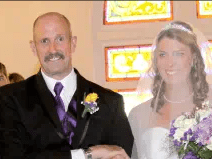The Challenge
When Chester, West Virginia native David Smith was 47 years old, he noticed a little twitch on the left side of his body that would come and go. He didn’t think much of it. He was a pretty healthy guy. Maybe muscle spasms, he thought.
"It really was amazing. I couldn’t believe how my shaking stopped, just like that." — David
Then, the twitches started to become more frequent. David knew that something wasn’t right, and made an appointment with a neurologist.
“I had a bad feeling that day I went to see the doctor.... And I was right.”
Schedule an Appointment or Ask a Question
David’s neurologist diagnosed him with Parkinson’s disease, a debilitating disease that affects parts of the brain that control body movement. At first, David was put on medication to help control the jerky arm and leg movements he was experiencing. While the medication helped, it did little to make him comfortable.
“I’d wake up and have tremors, and then I’d have to wait until the medication kicked in to see any relief. Then the tremors would start back up again after the pills wore off. It was basically like riding a rollercoaster. There was calm, and then there was chaos.”
As the years passed, David’s tremors became more aggressive. The small, barely noticeable movements had transformed into a thrashing, fast-paced back and forth rhythm that was as jarring as it appeared.
"I felt like a bird trying to fly, just flapping away like crazy and not going anywhere. It really was the worst I’ve ever felt, but not just for me, for my family too. They could see how bad I was suffering."
Because there is no cure for Parkinson’s disease, the symptoms eventually progressed to the point where medications no longer helped. This is what David was starting to experience. While the medications provided some relief, the severity of his tremors overran the medication.
He needed a better, more permanent solution, and luckily, his sister was right by his side to suggest one.
The Path to UPMC
David’s sister, a nurse, strongly recommended that they look into deep brain stimulation (DBS), a proven treatment for involuntary movements associated with Parkinson’s disease. DBS works by delivering electrical stimulation to targeted areas in the brain that control movement, blocking the neuronal signals that cause abnormal movement.
After doing extensive research and consulting with his neurologist, David made an appointment with a UPMC neurosurgeon. However, the meeting between the two almost never happened.
“On the day of my appointment, my tremors were so bad that I couldn’t even put on my belt, my socks, shoes, basically anything. I almost gave up and canceled. I’m glad I didn’t.”
During the initial meeting with David, now 60 years old, the surgeon was concerned with how severe his tremors were. David was completely covered in sweat due to his severe, constant tremors and the resulting stress on his body and mind. It was one of the worst tremors from Parkinson’s that the surgeon had ever seen.
The Solution
Because of the complexity of David’s symptoms, he was considered an excellent candidate for “asleep” DBS.
Most hospitals can only perform DBS while the patient is awake, but because of David’s extreme tremors, he would have had a very difficult time with the awake procedure.
Using the asleep method, UPMC neurosurgeons are able to perform deep brain stimulation inside a magnetic resonance imaging (MRI) scanner while the patient is under general anesthesia, allowing real-time images of the brain to guide the procedure.
David and his family agreed that this was the best solution, and set a date for the surgery. David had a special request though, one that the team would have to work hard to meet.
“My daughter was getting married in only a few months and I wanted to be able to walk her down the aisle without having tremors. This was really my main motivation. I wanted to do this for her.”
The UPMC medical team was able to meet David’s request and get him in for his surgery – with plenty of time to spare before the wedding.
The neurosurgeon performed the surgery in two stages over a two-day span. The first procedure was to implant the electrodes in David’s brain. The second was to hook up the electrodes to a small generator, which was implanted under the skin below the collarbone.
After a few days of recovery, David, with his family at his side, was ready to have the stimulator turned on.
“This was the day I’d been waiting for,” says David. “I was ready to get these tremors out of my body, for good.”
The Results
David’s medical team stood around him. “I’m ready,” he said. Then with the push of a button, the tremors stopped, instantly.
“Wow, wow…wow, I can’t believe this,” David repeated as his team fine-tuned the stimulator on the left side of his body, followed by the right.
For the first time in nearly 13 years, David sat motionless. There were no more tremors, no more violent shaking that left his shirts soaked with sweat.
“It really was amazing. I couldn’t believe how my shaking stopped, just like that. Now I don’t have trouble putting on my belt, or my shoes…it’s truly a miracle.”
But, the real miracle occurred a month-and-a-half later.
David extended his arm and his daughter Ashley held a tight grip. The bridal chorus started as they walked slowly down the aisle. Both had smiles from ear to ear.
“Dreams come true,” says David.
Our patient stories profile a number of patients who have had minimally invasive brain surgery at UPMC. Although everyone's care experience is unique, we hope that sharing these stories will help other prospective patients and their families better understand these procedures and their potential benefits.
David's treatment and results may not be representative of all similar cases.

















